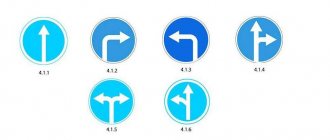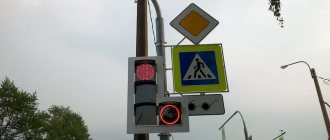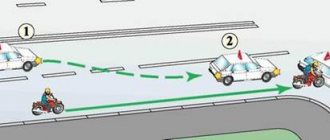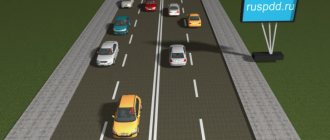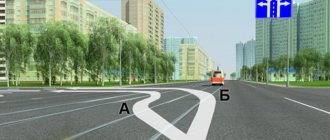The actions of drivers in situations where roads intersect are clearly regulated. In order to avoid penalties, you must confidently determine the intersection of roadways at an intersection. The fact is that their boundaries do not always coincide; at a complex intersection there may be several intersections of roadways, the rules of passage of which differ significantly. The ability to navigate in these areas is necessary for every road user.
Have you ever needed the help of a car lawyer?
Not really
Concepts of intersection and roadway
Let us quote paragraph 1.2 of the traffic rules:
Practical determination of the center point of an intersection can be difficult since the exact search methods are not specified.
To find the intersection of roadways, you should take a pair adjacent to the intersection and determine the area of its overlap.
In the figure, the intersection of roadways is highlighted with a yellow line. Let's look at some common options.
Choosing the correct turning trajectory at an intersection
The closer trajectory provides a safer turn at the intersection. It is the most convenient and safe, since it creates the minimum of problems for other traffic participants at the intersection.
However, performing a turn along a short trajectory does not always find understanding among traffic police officers, who claim that at the moment of making a turn, the car is moving towards the flow of vehicles for some time.
Such a statement is all the more controversial because when overtaking, the vehicle is also moving in the oncoming lane, but no one thinks of considering such a maneuver as a violation. The rules determine the impossibility of driving in the opposite direction only in prohibited places. In this situation, the prohibition on making such a U-turn is not stipulated by any of the clauses of the current traffic rules.
To confirm the above, we present one of the information posters located in the traffic police department and clearly illustrating a left turn at an intersection identical to the one discussed above.
The caption under the picture is clear and categorical: there is no violation. Moreover, the statement is true for both reversal trajectories. However, let's pay attention to one key point. Such a maneuver is permissible only when turning at an intersection with one intersection of roadways.
In what cases is a turn along a long trajectory recommended? If the distance from the car to the edge of the roadway is less than 10 meters, then when making a turn along a small radius there is a risk of hitting a curb, as shown in the figure.
This maneuver is fraught not only with possible damage to the chassis and steering components of the car, but also with the loss of its control. The seriousness of the problem lies in the fact that it is impossible to correct this situation without reversing, but according to traffic regulations, turning in reverse at an intersection is prohibited.
Increasing the turning radius by turning to the right does not solve the problem, since turning from the extreme right position is only allowed outside intersections.
The only correct turning trajectory at the intersection in this case is the far one, as shown in the figure.
But it would be a mistake to assume that turning around a large radius is a remedy for problems. A pedestrian crossing located close to the intersection may become an unexpected obstacle. The picture shows that the blue car ran into a zebra crossing, and turning around at a pedestrian crossing is considered a gross violation of traffic rules.
Or a solid center line marking, crossing which is no less strictly punishable.
The simplest intersection
The simplest intersection is the intersection of two roads at right angles. Junctions in the shape of the letter T also apply to simple intersections. To simplify perception, the image does not show the rounding of roadways.
Having designed the direction of the roads, we obtain the zone of their intersection of their roadways, indicated by a pink square.
There are 3 carriageways at the T-junction.
Let's imagine the intersection of roads in the form of a three-rayed star:
In this case, the intersection of roadways forms a triangle.
Adjacent to the intersection of two roads at an angle of ninety degrees, gives a square-shaped overlap area.
What is an uncontrolled intersection
Rules for driving through unregulated intersections
Since there are many non-parallel roads in the country, logically they will definitely intersect. Most often this happens at a right angle, resulting in the formation of a special part of the path from which you can continue the path in several directions:
- directly;
- turning to the right at a right angle;
- turning left at a right angle.
All manipulations in such a situation must be performed in accordance with current traffic regulations. The obligations of motorists are quite clearly stated there.
Traffic lights may be located at road intersections to help organize traffic. One by one, each group of cars has the opportunity to travel. Traffic police officers can also regulate traffic as traffic controllers.
Some car owners, due to inexperience or thoughtlessness, believe that driving through such areas is easier, although statistics say the opposite. A large number of traffic accidents occur on such sections of the route.
Road with a median
Quote:
Marking 1.2.1 is a solid line. A dividing strip can be thought of as a non-working section of the road on which you cannot move or stop. The functional purpose is to ensure the safety of road users. There is a separation of traffic flows. Driving into the oncoming lane becomes difficult or impossible.
A dividing strip is mandatory on the highway.
Crossroads with traffic lights. Traffic right at the intersection
When oncoming cars move at a traffic light or traffic controller's permitting signal in the direction straight and to the right, the trajectories of their movements do not intersect, so difficulties in passing the intersection usually do not arise. But there are several types of intersections at which even when moving “straight” you need to actively look to both sides. For example, at some intersections traffic is organized in such a way that additional lanes are created to make turns. In other words, one wide lane before the intersection bifurcates before crossing the roadway, and after the intersection it again turns into one lane.
At such intersections, road markings 1.18 and signs 5.15.2 indicate lane movement. But it happens that the markings are erased or not visible, and the signs 5.15.2 may not be immediately noticed. As a result, cars from additional lanes intended for turning begin to crowd towards the center of the roadway in order to go in the forward direction, thereby displacing other cars that are traveling nearby in the same direction into the oncoming lane or find themselves in the oncoming lane. The result of such inattention can have dire consequences.
A way out of such situations. If you find yourself in the wrong lane or realize it too late, follow the signs and markings. If the signs tell you to turn, turn. After this, look for a place to turn around and return to this intersection to continue in the direction you need. And if you know the area well, you can create a different route for yourself.
When driving through an intersection, you still need to understand the following: compliance with traffic rules certainly streamlines traffic, but does NOT guarantee safety. In a series of articles Road situations. Driving through an intersection directly examines several typical traffic situations in which any driver may find himself, and also gives recommendations on how to avoid unpleasant consequences.
There are intersections that have two intersections of roadways. Their peculiarity is that at some intersections there is a stop line, at others there is none. This is where the deceit lies.
Let's say you passed the first intersection at a green traffic light and are about to continue driving straight. But at this moment the green signal changes to yellow or red. What to do, stop, or continue moving?
The official solution to this question is provided by clause 13.7 of the traffic rules. If there is a Stop line at the intersection (marking 1.12 or sign 6.16), then you must stop in front of it. If there is no Stop Line, then you can move on and drive through the next intersection.
Now imagine this life situation. There is no stop line, which means that, according to clause 13.7, you are obliged to finish passing the intersection regardless of the traffic light signal at the exit. At the same time, another car starts moving along the road you are crossing at the green signal and, violating paragraph 13.8 of the traffic rules (perhaps it does not see you), sharply accelerates forward. As a result, a collision may occur.
The way out of such a situation will be like this. When driving to an intersection, you need to work through the possible development of events in your head. This is called predicting the situation taking into account “dead” or “blind” spots. Those. that space that you cannot see for some reason. When driving through the same intersection, the situation changes each time. If you see a huge bus on your right on the road you are crossing, you must assume that behind it, in your “blind” zone, there may be a smaller car that also cannot see you. Therefore, in the situation with our intersection, even if there is no Stop Line, it would be advisable to stop before the second intersection of the roadway.
You can read about turning at road intersections with medians in the articles of the same name: Turning at road intersections with medians Part 1, Part 2 and Part 3.
Dividing strip on one of the roads
A road with a dividing strip has two carriageways. The intersection of roads, one of which has a dividing strip, forms a complex intersection, shown in the figure:
Here the usual road is directed from left to right, and with a dividing strip from top to bottom. At such an intersection there are 2 separate intersections of roadways.
The area between the pink squares represents the roadway in the gap in the median.
The essence of the problem
The essence of the problem is that many drivers cannot decide for themselves which trajectory they will take to make a left turn or a U-turn at an intersection with a median.
There are 2 possible options:
In practice, of course, there are not two options, but significantly more, but we will dwell on two of them in more detail.
In addition, drivers are interested in whether a U-turn along a shorter trajectory is an entry into oncoming traffic , for which a penalty is provided in the form of deprivation of rights.
Crossroads of several roads
A roundabout is often organized at the intersection of several roads:
The intersection of roadways at a roundabout is shown in the figure:
It is a mistake to believe that stopping at such an intersection is prohibited.
The rules allow stopping no closer than 5m from the intersection of roadways, including at a roundabout intersection.
Performing a maneuver at a regular controlled intersection
You can turn a car around at a regular intersection with one intersection of roadways along a large or small trajectory.
Algorithm for turning around at a controlled intersection:
- Move your car into the leftmost lane in advance.
- When the traffic light turns on, drive to the center of the intersection.
- Give way to oncoming cars and complete the maneuver.
An alternative understanding of the intersection of roadways
There is an alternative to the generally accepted understanding of the term “crossing roadways.” Vehicles can move in pink-colored areas, which means they belong to the carriageways of one of the roads or are separate carriageways. Such reasoning leads to the conclusion that the boundaries of the intersection and the intersection of roadways coincide, therefore, the traffic rules change. The alternative understanding should not be used when taking a driver's license test or presented to a traffic inspector.

